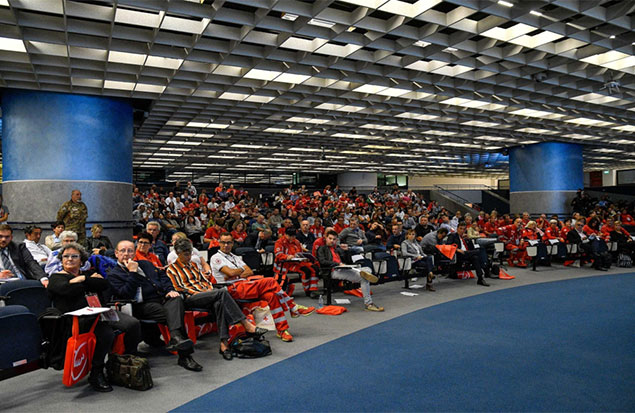11 October 2019, Verona – Italy, Lay People and Healthcare Professionals, a Link to Rescue
The second workshop was based on a roundtable and sought to analyze the connection between nonprofessional rescuers and the EMS systems with an emphasis on the need for primary centralization of patients flow management. The background of the participants referred to each link of the survival chain: an expert for Public Access Defibrillation programs, the National secretary of Italian Red Cross, the Dean of the University for Medicine of Rome, the CEO of Verona EMS and a representative from Bologna EMS. Each participant presented his/her point of view and experience regarding the connection between the EMS systems and lay population represented by volunteers and professional rescuers. The workshop concluded with an open debate with questions from the public.
This workshop was designed to describe the organization of the four aspects involved in everyday EMS activities: population, rescuers, territorial medical service, and primary centralization. Hence, an understanding is sought to be achieved on how the emergency system, through the four aspects mentioned above can improve patients’ survival in the case of cardiac arrest.
Read More
Participants in the discussion were: The President of the Progetto VITA Piacenza; a representative of the Italian Red Cross; representatives of EMS 118 Lazio, EMS 118 Verona and AUSL Bologna. The moderator asked the experts to describe the relationship between the different links in the survival chain, and the related gaps in the EMS system that need to be tackled.
The President of the “Progetto VITA” Piacenza indicated that the police need to be involved in the intervention in the instance of cardiac arrest. Indeed, police intervention, characterized by a fast arrival on the scene, may be crucial in areas where there are not many AEDs. Then she gave an example with the Piacenza reality where one AED is available for every 300 inhabitants. Finally, she concluded by stating that training is essential, and should be initiated in kindergartens and high schools.
The representative of Italian Red Cross remarked that there is a need to promote the use of the AED starting from the schools. He also proposed to create a national standard for the training course for volunteers.
The official from EMS 118 Lazio talked about the single emergency number 112 that has been already introduced in many Italian cities. At the moment, the unique number for emergency (NUE) covers only 1/3 of the territory. Further on, according to speaker there is a great need for technological innovation at the dispatch centers. The NUE is exposing problems of the system, namely, lacking in staff and weakness of the information technology systems in place.
The representative of 118 Verona stated that pre-arrival instructions are vital, especially with the help of the new technology, i.e. GPS technology, which can help EMS practitioners localize the victims, the available rescuers, and the closest AED. With the proper technology the dispatch center can make intervention easier for bystander. In a best-case scenario the dispatch should not “take the call, drive bystander, and send the ambulance” but only “take the call and send the ambulance”.
The official from AUSL Bologna said that there are no recommendations regarding the centralizations of cardiac arrest centers. Suggested by the scientific evidence, to produce benefit for the patient there is a need of a hospital that does all interventions such as angioplasty and target temperature management. Centralizing in this context means taking the patient to the hospital that follows and implements recommendations. However, this does not mean that the SPOKE hospitals are not able to manage the patient like the HUB hospitals.
The President of IRC concluded the event by summarizing the outcomes of the discussion and their implications.
11 October 2019
Verona – Italy


